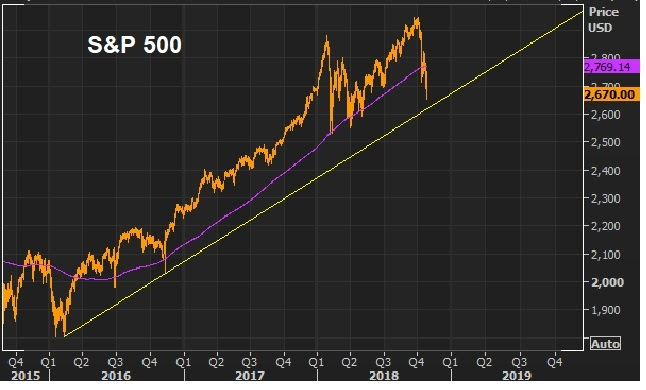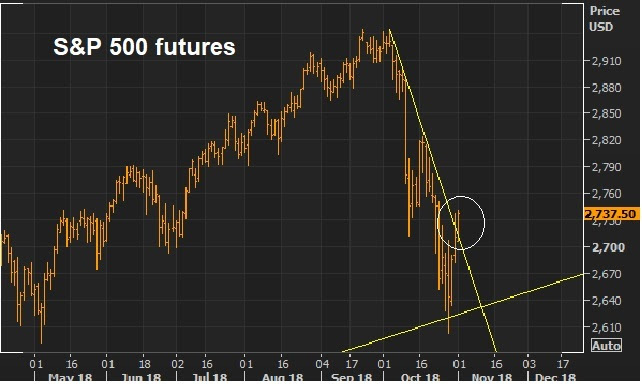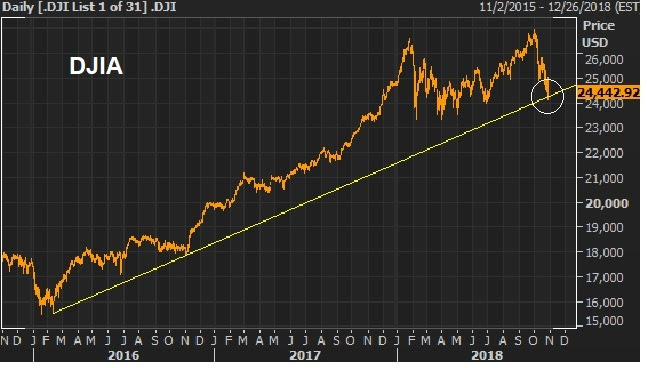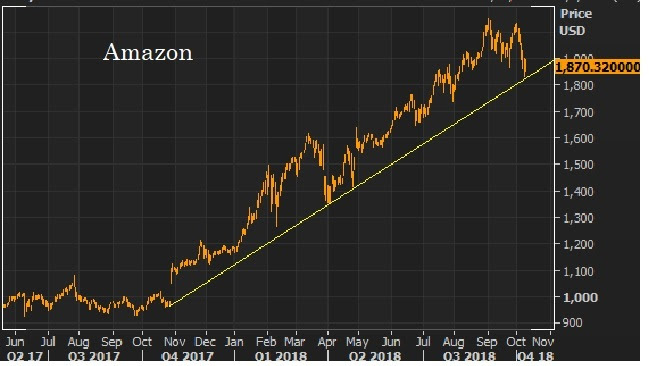|
|
October 31, 5:00 pm EST
As we discussed yesterday, it’s very dangerous to let political views influence your perspective on markets and investing.
And I suspect we are seeing plenty of people make that mistake.
That means many will be left behind on a stock market recovery, again. That probably means the bull market for stocks still has a ways to run. John Templeton, know to be one of the great value and contrarian investors of all time, said “bull markets are born on pessimism, grow on skepticism, mature on optimism and die on euphoria.”
Incredibly, after a more than four-fold run from the financial crisis bottom, the stock market continues to have a LOT of skepticism. Does this mean we are only half way through this cycle? Maybe.
The arguments for the stock market bears and pessimists on the economy have many holes, but the biggest is the lack of context. That context: the global economic crisis, and the aftermath (up to present day).
You can’t evaluate anything about this economy without taking into account where we’ve been over the past decade, the role central banks have played throughout, the coordinated intervention that has taken place globally (along the way) to avoid a global depression, and the interconnectedness of global economies that continues.
Without this context, the skeptics like to call it “late in the cycle” for an economy that (on paper) is in the second-longest expansion in U.S. history. With context, we’re probably closer to “early cycle,” given that the decade of ultra-slow growth was manufactured by central banks.
October 30, 5:00 pm EST
This violent repricing of the tech giants came with clear warnings (i.e. the tightening of regulatory screws).
Now that we have it. And it is very healthy, and needed.
As we discussed yesterday, I would argue we are seeing regulation priced-in on the tech giants, which can create a more level playing field for businesses, more broad-based economic activity, and a more broad-based bull market for stocks. This is a theme we’ve been discussing in my daily note here for quite sometime.
And I suspect now, we can see the areas of the stock market that have been beaten down, from the loss of market share to the tech giants, make aggressive comebacks.
On that note, here’s another look at the big trendline we’ve been watching in the Dow …

Again, this line holds right at the 10% correction mark. And we’ve now bounced more than 700 dow points.
As I’ve said, it’s easy to get sucked into the daily narratives in the financial media, and it’s especially easy and dangerous (to your net worth) when stocks are declining. They tend to influence people to sell, when they should be buying.
And as someone that has been involved in markets more than 20 years, I can tell you that it’s also very dangerous to let political views influence your perspective on markets and investing. And I suspect we are seeing that mistake made in this environment (by pros and amateurs alike).
If you need help with your shopping list of stocks to buy on this dip, join me in my Billionaire’s Portfolio. We follow the world’s bests billionaire investors into their favorite stocks. Click here to learn more.
|
|
|
October 25, 5:00 pm EST Yesterday we looked at this big trendline support in stocks (the yellow line).
|
 |
|
We had a good bounce today, but experience tells me that we will make a run at that trendline, and things will look a little messy before we bottom. We still have seven trading days before the mid-term elections. A stock market in correction is not as easy to promote as one at record highs (as we had just earlier this month). With that, I suspect there are plenty of interests (China among them) to keep the pressure on stocks in hopes of dividing U.S. Congress come November 6th. When the dust clears from the elections, market folks will realize that stocks are incredibly cheap at 15 times next year’s earnings estimates, in an economy growing better than 3%. On that note, we have our first look at third quarter GDP tomorrow. The market is looking for 3.6% growth, which would give us 3.22% annualized growth averaged over the past four quarters. That would be the best growth since 2006. If you need help with your shopping list of stocks to buy on this dip, join me in my Billionaire’s Portfolio. We follow the world’s bests billionaire investors into their favorite stocks. Click here to learn more. |
October 23, 5:00 pm EST
As we discussed yesterday, despite all of the drama about China, Italy,
Brexit, rates and the elections, what seems more likely to have driven the recent correction in stocks is Saudi selling.
In fact, I think it’s clear that there has been a Saudi liquidation (of U.S. and global assets) which was the catalyst for the correction in stocks earlier this year, and this recent decline.
Remember, in November of last year, the Saudi Crown Prince Salam, successor to the King, ordered the arrest of many of the most powerful Saudi Princes, country ministers and business people in Saudi Arabia on corruption charges. Over $100 billion in assets were claimed to be under investigation (a third frozen) in what was called the “Saudi purge.”
These subjects were detained for nearly three months. The timing of their release and the market correction of early this year is where it all begins to align.
They were released on Saturday, January 27. S&P futures open for trading on Sunday night. Stocks topped that night and proceeded to drop 12% in six days. And rallies in stocks were sold aggressively for the better part of the next seven months.
Fast forward to this month, and we have the murder of the journalist that was a public critic of the Crown Prince Salam. As the details of story pointed back to Salam, on Oct 3, U.S. bond markets got hit (to the hour of news hitting the wires) and stocks topped that day, and have proceeded to drop by more than 8%.
Clearly, the destabilization in Saudi Arabia has put considerable assets in jeopardy. With that, those in control of those assets have likely been scrambling to protect them, as U.S. Congress pushes for sanctions, which could include freezing Saudi assets.
|
October 22, 5:00 pm EST As the events surrounding Saudi Arabia continue to unfold, it is beginning to look more and more like the market shakeup of the past three weeks was triggered by Saudi selling. The top in stocks and the heavy selling came just as news was hitting wires that Khashoggi never exited the Saudi consulate in Turkey – disputing the story of the Saudi government. Stocks put in a top that day.
|
 |
|
And that was the day the bond market also made it’s move — the 10-year yield spiked from 3.08% to 3.18%.
|
 |
|
Here’s what hit the news wires that triggered the selling in bonds/rise in market rates – to the hour.
|
 |
|
So, was the catalyst for this market correction triggered by money from Saudi Arabia moving to escape a potential asset freeze? It looks possible. We constantly hear predictions of impending corrections, pointing to all of the clear evidence that should drive it, but corrections are often caused by events that are less pervasive in the market psyche. The Saudi story would qualify. If you need help with your shopping list of stocks to buy on this dip, join me in my Billionaire’s Portfolio. We follow the world’s bests billionaire investors into their favorite stocks. Click here to learn more. |
|
October 18, 5:00 pm EST Last week, we talked about the signals coming from China, that the economy is running dangerously slow, and their backs are against the wall. They cut their bank reserve requirement ratio last week for the fourth time this year. And they have been continually walking down the value of their currency (the yuan). The PBOC pegged the yuan to another 21-month low today. Most importantly, it’s getting closer and closer to the 7 yuan per dollar level – a level we haven’t seen since the pre-financial crisis days. As we’ve discussed, they have two options. They can play ball on trade concessions with the U.S. If so, the economy slows. They can continue to holdout/pushback on trade, and the trade sanctions may take the economy off the cliff. Both scenarios mean China’s rapid ascent to economic power gets knocked off path. If holdout is their long term strategy, I suspect we will find that global trading partners will join Trump’s fight against China’s rigging of global trade via its weak currency advantage. That’s not a good outcome for China. More likely, China is trying to holdout to see the outcome of the November U.S. elections. And as we discussed earlier this month, they are likely trying to wield some influence: “they can sell Treasurys, in an attempt to ignite a sharper climb in rates. And a fast move in rates (at these levels) has a way of shaking confidence in equity markets–which has a way of shaking confidence in the economy.” It appears that it may be playing out, but worse for Chinese stocks, which are now down 25% for the year.
|
 |
|
If you need help with your shopping list of stocks to buy on this dip, join me in my Billionaire’s Portfolio. We follow the world’s bests billionaire investors into their favorite stocks. Click here to learn more. |










